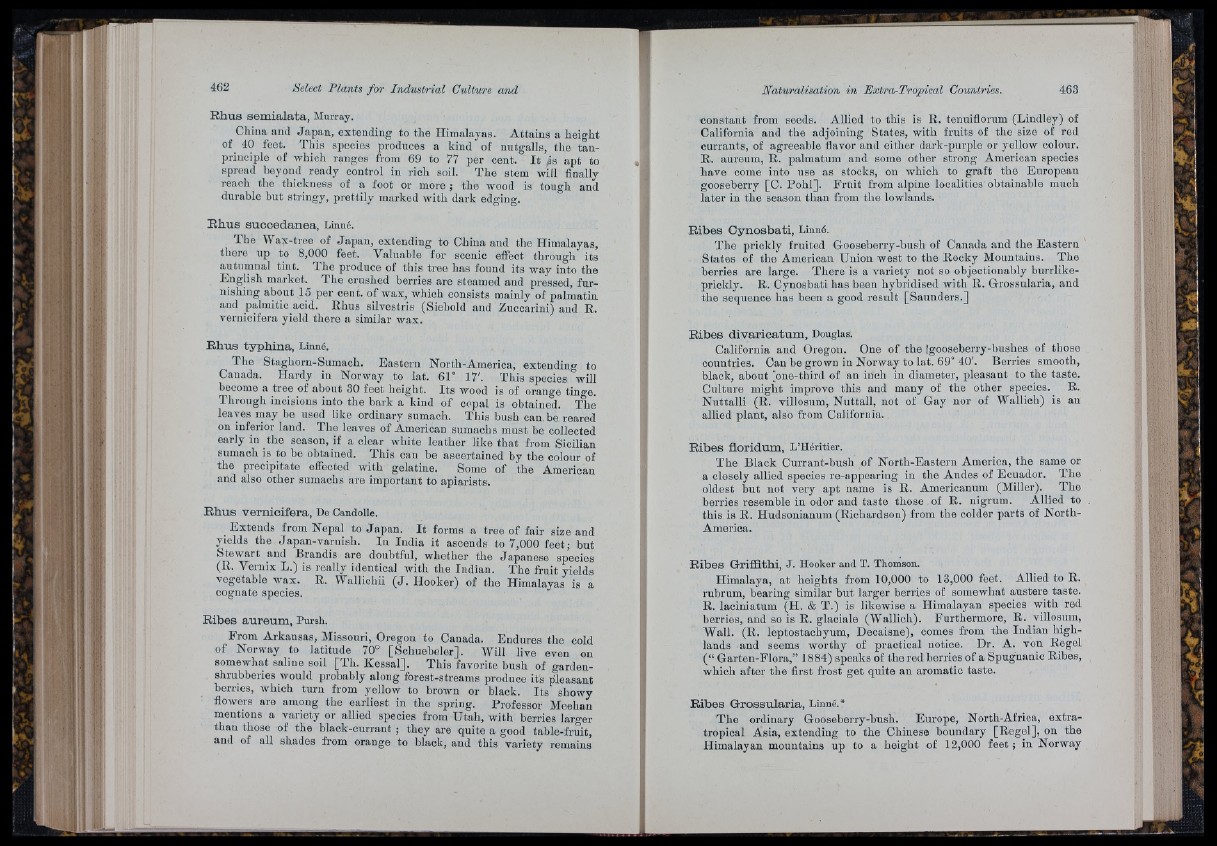
)4If
it
i
R h u s s em ia la ta , Murray.
China and Jap an , extending to the Himalayas. Attains a height
of 40 feet. This species produces a kind of nutgalls, the tau-
priiieiplo of whicli ranges from 69 to 77 per cent. I t js apt to
spread beyond ready control in rich soil. Tho stem will finally
reach tlie tliickness of a foot or more ; the wood is tough and
durable but stringy, prettily marked witli dark edging.
R h u s s u c c e d a n e a , Linné.
I he W ax-tree of J apan, extending to China and tlie Himalayas,
tliei'o up to 8,000 feet. Valuable for scenic effect through its
autumnal tint. The produce of this tree has found its way into the
English market. The cnislied berries are steamed and pressed, furnishing
about 15 por cent, of wax, which consists mainly of palmatin
and palmitic acid. Rhus silvestris (Siebold and Zuccarini) and R.
veriiicifera yield there a similar wax.
R h u s ty p h in a , Linné.
Tlie Staghoni-Sumacli. Eastern North-America, extending to
Canada. Hardy in Norway to lat. 61” 17'. 'This species will
become a tree of about 30 feet lieight. I ts wood is of orange tinge.
'Throngh incisions into the bark a kind o f copal is obtained. 'The
leaves may be used like ordinary sumach. This bush can. be reared
on inferior land. 'The leaves of American sumachs must be collected
early in the season, if a clear white leather like th a t from Sicilian
sumach is to be obtained. 'This can be ascertained by the colour of
the precipitate effected with gelatine. Some of the American
and also other sumachs are important to apiarists.
R h u s v e r n i o i f e r a , D e C a n d o l l e .
Extends from Nepal to Jap an . I t forms a tree of fair size and
yields the Japan-varuisli. In India it ascends to 7,000 feet; but
Stewart and Brandis are doubtful, whether the Japanese species
(R. Veriiix L.) is roaily identical with the Indian. 'The fruit yields
vegetable wax. R. Walliohii ( J . Hooker) of the Himalayas is a
cognate species.
R ib e s a u re um , Pursh.
From Arkansas, Missouri, Oregon to Canada. Endures the cold
of Norway to latitude 70° [Schuebeler]. Will live even on
somewhat saline soil ['Th. Kessal]. 'This favorite bush of gardeu-
shrubberies would probably along forest-streams produce its pleasant
berries, wliich turn from yellow to brown or black. I ts showy
flowers are among the earliest in the spring. Professor Meehan
mentions a variety or allied species from Utah, with berries larger
than those of the black-currant ; they are quite a good table-fruit,
and of all shades from orange to black, and this variety remains
constant from seeds. Allied to this is R. tenuiflorum (Lindley) of
California and the adjoining States, with fruits of the size of red
currants, of agreeable flavor and either dark-purple or yellow colour.
R. aureum, R. palmatum and some other strong American species
have come into use as stocks, on which to graft the European
gooseberry [C. Pohl]. F ru it from alpine localities obtainable much
later in the season than from the lowlands.
R ib e s C y n o sb a ti, Linné.
'The prickly fruited Gooseberry-bush of Canada and the Eastern
States of the American Union west to the Rooky Mountains. 'The
berries are large. 'Pliere is a variety not so objectionably burrlike-
prickly. R. Cynosbati has been hybridised with R. Grossularia, and
the sequence has been a good result [Saunders.]
R ib e s d iv a r ic a tum , Douglas.
California and Cregon. Cne of the [gooseberry-bushes of those
countries. Can be grown in Norway to lat. 69° 40'. Berries smooth,
black, about (one-third of an inch iu diameter, pleasant to the taste.
Culture might improve this and many of the other species. R.
Nuttalli (R. villosum, Nuttall, not of Gay nor of Wallich) is an
allied plant, also from California.
R ib e s flo rid um , L’Héritier.
'The Black Currant-bush of North-Eastorn America, the same or
a closely allied species re-appearing iu the Andes of Ecuador. 'The
oldest but not very apt name is B. Americauum (Miller). 'The
berries resemble in odor and taste those of R. nigrum. Allied to
this is R. Hudsoiiianum (Richardson) from the colder parts of North-
America.
R ib e s Grifflthi, J. Hooker and T. Thomson.
Himalaya, a t heights from 10,000 to 13,000 feet. Allied to R.
rubrum, bearing similar but larger berries of somewliat austere taste.
R. laoiniatum (H. & 'T.) is likewise a Himalayan species with red
berries, and so is E . glaciale (Wallich). Furthermore, R. villosum,
Wall. (R. leptostachyum, Decaisne), comes from the Indian liigh-
lands and seems worthy of practical notice. Dr. A. von Rogel
( “ Garten-Flora,” 1884) speaks of tho rod berries of a Spugnanic Ribes,
which after tlie first frost get quite an aromatic taste.
R ib e s G ro s su la ria , Linné.*
The ordinary Gooseberry-bush. Europe, North-Africa, extra-
tropical Asia, extending to the Chinese boundary [Rcgel], on the
Himalayan mountains up to a height of 12,000 feet ; in Norway
If i